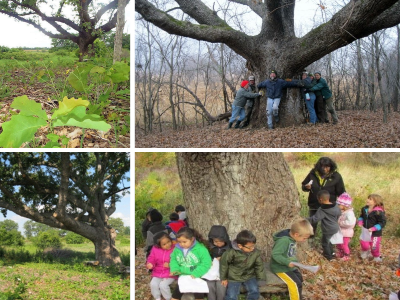
Betty White Oak
McHenry County’s oldest resident was struck down by the derecho wind on Aug. 10, 2020

(Clockwise from left) An oak seedling thrives in shadow of Betty White Oak, a group of volunteers gives the tree some love, preschoolers from Brown Bear in Harvard visit and learn from the tree, a view of the tree in summer.
Betty White Oak
b. circa May 1611
d. August 10, 2020
McHenry County’s oldest resident was struck down by the derecho wind on Aug. 10, 2020, after living 400-plus years in a lovely spot overlooking Rush Creek near modern-day Harvard, Illinois.
Over her lifetime, Betty provided food and shelter to thousands – perhaps millions – of visitors. She embraced all who came to her, from caterpillars and woodpeckers to mice, deer and perhaps bison. She offered shade to Potawatomi Indians passing through the area 300 years ago, sheltered livestock for Orson Diggins in the 1870s, and provided a world to explore for Dan Hereley and his siblings in the 1950s. TLC purchased the property from the Hereleys, and on New Year’s Eve, 2011, Betty was rediscovered by a group of TLC volunteers who were clearing brush at what is now Gateway Park. Since then, she enjoyed many human visitors.
Betty is survived by an unknown number of white oak trees at Gateway Park, in the greater Harvard area, and probably in Wisconsin.
In her memory, please do what you can to conserve oak woodlands for the future by planting oaks and clearing invasive brush from around oaks so they can stretch out and have the chance to live long lives like Betty did.
————————
What Happens Now?
Over 400 years, a tree creates a lot of wood – literally several hundred tons of wood held aloft by its massive trunk and network of branches – some as large as tree trunks themselves. What happens when all that wood crashes to the ground?
We wondered how to remember Betty, and help future visitors experience the wonder of a tree that large and old?
Our first priority was to make sure no one got hurt climbing on the fallen tree limbs, so we closed the trail on either side of the tree. Then, we started working with some neighbors, Keith Symon and Sharon Button, who helped dismantle the tree to remove many of the hazards to the public and to stabilize the pieces that will remain in place.
The wood that is reclaimed from the tree will be used in a variety of ways: some will become bowls, perhaps available at future TLC silent auctions; some limbs will be turned into lumber and used to enlarge the bridges that cross Rush Creek; some branches were cut into slices (cookies) that will be sealed and used for making awards in the future; and artists have been encouraged to visit the site to take smaller pieces of wood for projects – or just to have for inspiration in their studios!
We hope to have a day soon when artisans can gather on site with Keith to see if there are some specific pieces he could cut for their work.
Much of the tree will remain in place as a visual reminder of the tree herself, for even dead, the trunk and main branches tell a story of strength and resilience that all can learn from. The massive trunk will become an Ofrenda for Day of the Dead.
Even in death, Betty will continue to welcome a wide diversity of visitors to her side.